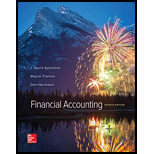
Financial Accounting
4th Edition
ISBN: 9781259307959
Author: J. David Spiceland, Wayne M Thomas, Don Herrmann
Publisher: McGraw-Hill Education
expand_more
expand_more
format_list_bulleted
Concept explainers
Textbook Question
Chapter 7, Problem 20RQ
Assume that Little King Sandwiches uses straight-line
Expert Solution & Answer
Want to see the full answer?
Check out a sample textbook solution
Students have asked these similar questions
I don't need ai answer general accounting question
Hii ticher please given answer general accounting
general accounting
Chapter 7 Solutions
Financial Accounting
Ch. 7 - Prob. 1RQCh. 7 - What are the two major categories of long-term...Ch. 7 - Prob. 3RQCh. 7 - Prob. 4RQCh. 7 - Prob. 5RQCh. 7 - Prob. 6RQCh. 7 - Equipment includes machinery used in manufacturing...Ch. 7 - Prob. 8RQCh. 7 - Prob. 9RQCh. 7 - Prob. 10RQ
Ch. 7 - Prob. 11RQCh. 7 - How do we decide whether to capitalize (record as...Ch. 7 - Explain the usual accounting treatment for repairs...Ch. 7 - Prob. 14RQCh. 7 - How is the dictionary definition different from...Ch. 7 - What factors must we estimate in allocating the...Ch. 7 - Prob. 17RQCh. 7 - Prob. 18RQCh. 7 - Prob. 19RQCh. 7 - Assume that Little King Sandwiches uses...Ch. 7 - Assume Little King Sandwiches depreciates a...Ch. 7 - Prob. 22RQCh. 7 - Prob. 23RQCh. 7 - What is book value? How do we compute the gain or...Ch. 7 - Prob. 25RQCh. 7 - Prob. 26RQCh. 7 - Prob. 27RQCh. 7 - Prob. 28RQCh. 7 - Determine the initial cost of land (LO71) Fresh...Ch. 7 - Prob. 7.2BECh. 7 - Prob. 7.3BECh. 7 - Compute research and development expense (LO72)...Ch. 7 - Prob. 7.5BECh. 7 - Explain the accounting definition of depreciation...Ch. 7 - Prob. 7.7BECh. 7 - Prob. 7.8BECh. 7 - Prob. 7.9BECh. 7 - Account for the sale of long-term assets (LO76)...Ch. 7 - Account for the exchange of long-term assets...Ch. 7 - Account for the exchange of long-term assets...Ch. 7 - Prob. 7.13BECh. 7 - Determine the impairment loss (LO78) Vegetarian...Ch. 7 - Prob. 7.15BECh. 7 - McCoys Fish House purchases a tract of land and an...Ch. 7 - Orion Flour Mills purchased a new machine and made...Ch. 7 - Prob. 7.3ECh. 7 - Prob. 7.4ECh. 7 - Prob. 7.5ECh. 7 - Prob. 7.6ECh. 7 - Prob. 7.7ECh. 7 - Prob. 7.8ECh. 7 - Prob. 7.9ECh. 7 - Determine depreciation for the first year under...Ch. 7 - Deformine depreciation under three methods (LO74)...Ch. 7 - Determine straight-line depreciation for partial...Ch. 7 - Determine straight-line depreciation for partial...Ch. 7 - Prob. 7.14ECh. 7 - Prob. 7.15ECh. 7 - Prob. 7.16ECh. 7 - Record the sole of equipment (L076) Abbott...Ch. 7 - Prob. 7.18ECh. 7 - Prob. 7.19ECh. 7 - Prob. 7.20ECh. 7 - Complete the accounting cycle using long-term...Ch. 7 - The Italian Bread Company purchased land as a...Ch. 7 - Prob. 7.2APCh. 7 - Prob. 7.3APCh. 7 - Prob. 7.4APCh. 7 - Determine depreciation under three methods (LO74)...Ch. 7 - Prob. 7.6APCh. 7 - Compute depreciation, amortization, and book value...Ch. 7 - Prob. 7.8APCh. 7 - Calculate and interpret ratios (LO77) Sub Station...Ch. 7 - Calculate and interpret ratios (LO77) University...Ch. 7 - Prob. 7.1BPCh. 7 - Determine the acquisition cost of equipment (LO71)...Ch. 7 - Prob. 7.3BPCh. 7 - Prob. 7.4BPCh. 7 - Determine depreciation under three methods (LO74)...Ch. 7 - Prob. 7.6BPCh. 7 - Prob. 7.7BPCh. 7 - Record the disposal of equipment (LO76) Flip Side...Ch. 7 - Calculate and Interpret ratios (LO77) Papas Pizza...Ch. 7 - Calculate and interpret ratios (LO77) Barry...Ch. 7 - Prob. 7.1APCPCh. 7 - Prob. 7.2APFACh. 7 - Prob. 7.3APFACh. 7 - Prob. 7.4APCACh. 7 - Prob. 7.5APECh. 7 - Written Communication At a recent luncheon, you...Ch. 7 - Earnings Management Edward L. Vincent is CFO of...
Knowledge Booster
Learn more about
Need a deep-dive on the concept behind this application? Look no further. Learn more about this topic, accounting and related others by exploring similar questions and additional content below.Similar questions
arrow_back_ios
SEE MORE QUESTIONS
arrow_forward_ios
Recommended textbooks for you
 Financial Reporting, Financial Statement Analysis...FinanceISBN:9781285190907Author:James M. Wahlen, Stephen P. Baginski, Mark BradshawPublisher:Cengage Learning
Financial Reporting, Financial Statement Analysis...FinanceISBN:9781285190907Author:James M. Wahlen, Stephen P. Baginski, Mark BradshawPublisher:Cengage Learning Auditing: A Risk Based-Approach (MindTap Course L...AccountingISBN:9781337619455Author:Karla M Johnstone, Audrey A. Gramling, Larry E. RittenbergPublisher:Cengage Learning
Auditing: A Risk Based-Approach (MindTap Course L...AccountingISBN:9781337619455Author:Karla M Johnstone, Audrey A. Gramling, Larry E. RittenbergPublisher:Cengage Learning Cornerstones of Financial AccountingAccountingISBN:9781337690881Author:Jay Rich, Jeff JonesPublisher:Cengage Learning
Cornerstones of Financial AccountingAccountingISBN:9781337690881Author:Jay Rich, Jeff JonesPublisher:Cengage Learning

Financial Reporting, Financial Statement Analysis...
Finance
ISBN:9781285190907
Author:James M. Wahlen, Stephen P. Baginski, Mark Bradshaw
Publisher:Cengage Learning

Auditing: A Risk Based-Approach (MindTap Course L...
Accounting
ISBN:9781337619455
Author:Karla M Johnstone, Audrey A. Gramling, Larry E. Rittenberg
Publisher:Cengage Learning

Cornerstones of Financial Accounting
Accounting
ISBN:9781337690881
Author:Jay Rich, Jeff Jones
Publisher:Cengage Learning
Accounting for Derivatives_1.mp4; Author: DVRamanaXIMB;https://www.youtube.com/watch?v=kZky1jIiCN0;License: Standard Youtube License
Depreciation|(Concept and Methods); Author: easyCBSE commerce lectures;https://www.youtube.com/watch?v=w4lScJke6CA;License: Standard YouTube License, CC-BY